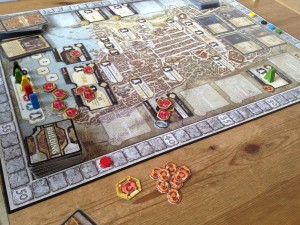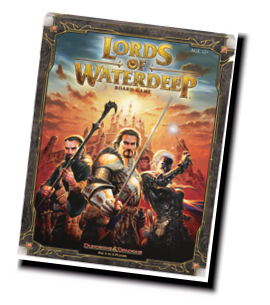Review: Lords of Waterdeep
Posted by James (admin) on September 14th, 2012
 I wasn’t expecting much when Lords of Waterdeep was announced as Dungeons and Dragons-based board games have been pretty lack lustre in the past (the drab Castle Ravenloft being one). However, Lords of Waterdeep is very good with more of a eurogame at its heart.
I wasn’t expecting much when Lords of Waterdeep was announced as Dungeons and Dragons-based board games have been pretty lack lustre in the past (the drab Castle Ravenloft being one). However, Lords of Waterdeep is very good with more of a eurogame at its heart.
During the game, players try to earn as many points as possible by completing their quests. Each quest is completed by sending (spending) the number of adventurers (clerics, rogues, fighters and wizards) shown on the quest, and some quests give the player a special ability too. The main game mechanic is a worker placement game and, on their turn, a player places one of their agents (workers) onto the board and uses the benefit of that location. Locations can give the player adventurers, money, allow them to take a new quest from those on display, build a building (paying resources to do so), etc. One interesting location is the harbour which not only allows players to play one of the Intrigue card they may hold (which can be very beneficial to the player, or detrimental to opponents), but agents at the harbour also get to be reassigned to any free locations after all the other agents have been placed.
Like any other location, the buildings built by players as an action can be used by any player by placing an agent there as usual (and the owner gets a benefit if another player uses their building). The effects of the 24 buildings are very varied allowing players to do things like add an agent to a location even though it has already been used, etc.
At the start of the game. each player is given a random one of the 11 Lords of Waterdeep cards which are secret until the end of the game when players reveal them and score extra points if they have completed types of quests that match what their Lord of Waterdeep card says (plus a few points for any unused adventurers and cash). The game ends after 8 rounds and the player with the most points wins.
 Overall, Lords of Waterdeep is a worker placement game with a good theme and good balance. The worker placement offers what good worker placement games should – agonising decisions (over which locations to place your workers) and tension (whilst you wait to see if opponents will get in your way and take the location you want to take next). The buildings are an interesting addition as they work well and offer lots of new locations to use – plenty of games allow buildings to be built for anyone to use and give their owner a benefit when they are, but I don’t recall seeing it much in worker placement games (Caylus being one I can think of). As a result, each game will be a bit different as different buildings get built and even the same buildings may appear but in a different order.
Overall, Lords of Waterdeep is a worker placement game with a good theme and good balance. The worker placement offers what good worker placement games should – agonising decisions (over which locations to place your workers) and tension (whilst you wait to see if opponents will get in your way and take the location you want to take next). The buildings are an interesting addition as they work well and offer lots of new locations to use – plenty of games allow buildings to be built for anyone to use and give their owner a benefit when they are, but I don’t recall seeing it much in worker placement games (Caylus being one I can think of). As a result, each game will be a bit different as different buildings get built and even the same buildings may appear but in a different order.
The amount of workers was well-balanced against the number of new locations being added (buildings being built) too – all players get 1 more agent half-way through the game (there are a couple of extra neutral ones that players can control as well) and I never felt there were too few locations or too few agents.
When I considered Lords of Waterdeep, I realised there aren’t really any brand new ideas in the game – the buildings that have not been built each round are made more enticing (like races in Small World), the worker placement is like many others (place worker, gain resources, use resources to gain points), secret objectives revealed at the end of the game have been done before, etc. However, whilst it may not contain anything completely new, Lords of Waterdeep just combines all these game mechanics really well and some mechanics are different enough so that the game has its own identity and doesn’t feel like a rehash of another game.
I thought there were a couple of minor negative points about the game. One was that I wasn’t really able to focus on what other people were trying to do because there’re so many different quests in-front of each player requiring various mixtures of adventurers that it’s hard to focus on what they may need from their worker placement as well as what they might be planning next. Not that this is a problem – and you can check every now and again if there’s a key decision to make – but it does mean there’s less opportunity to consciously hinder them (and still fun when you do by accident).
The other minor negative was that new quests that can be selected by players are drawn at random. This means that sometimes easy-to-complete quests fall into the lap of the player who could instantly (or quickly) complete them, plus sometimes there aren’t any quests that really match your current status. Also, I’d like the quests to come out in a more even fashion as sometimes there can be lots of very difficult quests all at once, and sometimes only very easy quests are available, which can be frustrating. So, there’s a bit of luck in the timing of what quests are available.
I’d like to try the game with 2 and 3 players as there’d more chance to watch what the opponents are doing, although fewer players in a worker placement game usually means slightly less competition over resources.
In the end, Lords of Waterdeep is a surprisingly good worker placement game with a strong theme and variety in replay too. It’s one I want to add to my games collection.
James.
[Played with 5 players]
P.S. The only thing that annoyed me about Lords of Waterdeep is that it was so similar to a game I’ve been designing with quests for different fantasy classes of meeple to go on (and even with a tavern for each player where the unallocated characters would be). This has happened before too – I was playing with ideas for a Black Death game when Rattus was announced, and when I was designing a Great Fire of London game I walked up the stairs at a UK convention to see a big poster for the Great Fire of London, stopped, and simply said, “Bugger.” Oh well, plenty of other ideas and I’m pleased Lords of Waterdeep was good as I feel like I was proved right.

